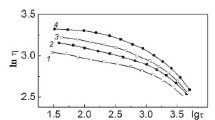Abstract
Conditions for obtaining L-aspartic acid solutions of chitosan were considered: dissolution of the polymer with the formation of chitosan aspartate occurs in pH range of 3.6–3.8 at a minimum stoichiometric ratio of [acid]/[chitosan (−NH2)] ∼ 0.43. The hydrodynamic, electrochemical, optical and biological properties of aqueous solutions of chitosan aspartic acid salt are investigated. It has been established that macromolecules of polymeric salt exhibit properties of a polyelectrolyte with a partially compensated charge in an aqueous medium. Huggins constants and temperature viscosity coefficients were calculated, which indicate an increased rigidity of the chitosan macrochain in the studied solutions and deterioration in the polymer—solvent interaction with increasing temperature. Chitosan aspartate powders in the form of lamellar microparticles with fractal ordering were isolated. Low biocompatibility and antibacterial activity of the polymeric salt are demonstrated, which allows recommending the production of biomedical products on its basis.
Similar content being viewed by others
References
Rinaudo, M., Progress Polym. Sci., 2006, vol. 31, no. 7, pp. 7–603. https://doi.org/10.1016/j.progpolymsci.2006.06.001
Mikhailov, G.P., Tuchkov, S.V., and Lazarev, V.V., Kulish, E.I., Russ. J. Phys. Chem., 2014, vol. 88, no. 6, pp. 6–936. https://doi.org/10.1134/S0036024414060181
Chaouat, C., Balayssac, S., Malet-Martino, M., Belaubre, F., Questel, E., Schmitt, A.M., Poigny, S., Franceschi, S., and Perez, E.J., Microencapsul, 2017, vol. 34, no. 2, pp. 2–162. https://doi.org/10.1080/02652048.2017.1311956
Fedoseeva, E.N. and Fedoseev, V.B., Polym. Sci. Ser. A, 2011, vol. 53, no. 11, pp. 11–1040. https://doi.org/10.1134/S0965545X1110004X.
Sanli, O., Karaca, I., and Isiklan, N.J., Appl. Polym., 2009, vol. 111, no. 6, pp. 6–2731. https://doi.org/10.1002/app.29319
Gegel, N.O., Zhuravleva, Yu.Yu., Shipovskaya, A.B., Malinkina, O.N., and Zudina, I.V., Polymers, 2018, vol. 10, no. 3. pp. 259–275. https://doi.org/10.3390%2Fpolym10030259
Gegel, N.O., Zudina, I.V., Malinkina, O.N., and Shipovskaya, A.B., Microbiology, 2018, vol. 8, no. 2, pp. 2–732. https://doi.org/10.1134/S0026261718050107
Begin, A. and Van Calsteren, M.-R., Int. J. Biological Macromolec., 1999, vol. 26, no. 1, pp. 1–63. https://doi.org/10.1016/S0141-8130(99)00064-1
Sedyakina, N.E., Zakharov, A.N., Krivoshchepov, A.F., Pribytkova, A.P., Bogdanova, Y.A., Feldman, N.B., Lutsenko, S.V., and Avramenko, G.V., Colloid Polym. Sci., 2017, vol. 295, no. 10, pp. 10–1915. https://doi.org/10.1007/s00396-017-4171-0
Chashchin, I.S., Abramchuk, S.S., and Nikitin, L.N., Dokl. Phys. Chem., 2017, vol. 475, no. 1, pp. 1–134. https://doi.org/10.1134/S0012501617070041
Rafey, A., Shrivastavaa, K.B.L., Iqbal, S.A., and Khan, Z.J., Solloid Interface Sci., 2011, vol. 354, no. 1, pp. 1–190. https://doi.org/10.1016/j.jcis.2010.10.046
Li, Q., Song, B., Yang, Z., and Fan, H., Carbohydrate Polym., 2006, vol. 63, pp. 272–282. https://doi.org/10.1016/j.carbpol.2005.09.024
Kuzina, L.G., Murzagil’dina, A.S., Chernova, VV, and Kulish, E.I., Vestn. Bashkir. Univ., 2012, vol. 17, no. 2. pp. 902–905.
Mikhailov, G.P. and Lazarev, V.V., Russ. J. Phys. Chem., 2016, vol. 90, no. 7, pp. 7–1367. https://doi.org/10.1134/S0036024416070207
Kulish, E.I., Chernova, V.V., Volodina, V.P., and Kolesov, S.U., Polym. Sci. Ser. A, 2015, vol. 57, no. 5, pp. 5–508. https://doi.org/10.1134/S0965545X15050120.
Kasaai, M.R., Arul, J., The Scientific World J., 2013, Article ID 508540. https://doi.org/10.1155/2013/508540
Bobreshova, O.V., Bobylkina, O.V., Kulintsov, P.I., Bobrinskaya, G.A., Varlamov, V.P., and Nemtsev, S.V., Russ. J. Electrochem., 2004, vol. 40, no. 7, pp. 7–694. https://doi.org/10.1023/B:RUEL.0000035250.54523.e8
Vasnev, V.A., Tarasov, A.I., and Markova, G.D., Polym. Sci. Ser. B, 2003, vol. 45, no. 9–10, pp. 319–320.
Ageev, E.P., Vikhoreva, G.A., Zotkin, M.A., Matushkina, N.N., Gerasimov, V.I., Zezin, S.B., and Obolonkova, E.S., Polym. Sci. Ser. A, 2004, vol. 46, no. 12, pp. 12–1245.
Kasatkina, M.A., Kil’deeva, N.R., and Budantseva, N.A., Phartical Chem. J., 2016, vol. 50, no. 4, pp. 4–250. https://doi.org/10.1007/s11094-016-1432-z
Shipovskaya, A.B., Rudenko, D.A, Fomina, V.I., and Ostrovsky, N.V., Eur. J. Nat. Hist., 2012, no. 6, pp. 7–12.
Aksenova, N.A., Timofeeva, V.A., Rogovina, S.Z., Timashev, P.S., Glagolev, N.N., and Solov’eva, A.B., Polym. Sci. Ser. B, 2010, vol. 52, no. 1–2, pp. 67–72. https://doi.org/10.1134/S1560090410010100
Lugovitskaya, T.N. and Shipovskaya, A.B., Russ. J. Gen. Chem., 2017, vol. 87, no. 4, pp. 4–782. https://doi.org/10.1134/S1070363217040193
Gamzazadea, A.I., Sklyar, A.M., Rogozhin, S.V., and Pavlova, S.-S.A., Polym. Sci. USSR, 1985, vol. 27, no. 4, pp. 4–936. https://doi.org/10.1016/0032-3950(85)90437-X
Rumyantsev, A.M. and Kramarenko, E.Yu., Soft Matter., 2017, vol. 13, pp. 6831–6844. https://doi.org/10.1039/C7SM01340J
Author information
Authors and Affiliations
Corresponding author
Ethics declarations
The authors declare that there is no conflict of interest requiring disclosure in this article.
Additional information
Russian Text © The Author(s), 2020, published in Zhurnal Prikladnoi Khimii, 2020, Vol. 93, No. 1, pp. 90–99.
Rights and permissions
About this article
Cite this article
Lugovitskaya, T.N., Zudina, I.V. & Shipovskaya, A.B. Obtaining and Properties of L-Aspartic Acid Solutions of Chitosan. Russ J Appl Chem 93, 80–88 (2020). https://doi.org/10.1134/S1070427220010097
Received:
Revised:
Accepted:
Published:
Issue Date:
DOI: https://doi.org/10.1134/S1070427220010097



